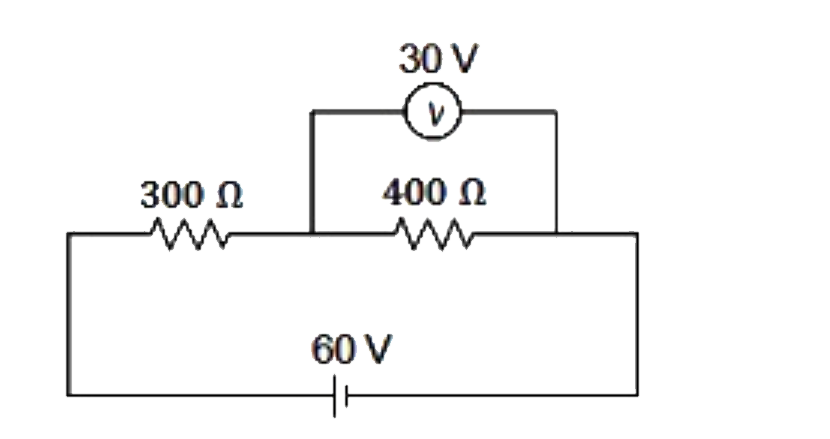To convert a voltmeter measuring 15V into a voltmeter measuring 150V, if the resistance of the voltmeter is 1000Ω, the resistance to be connected is
10,000Ω in series
9,000Ω in series
11000Ω in series
8000Ω in series
The correct Answer is:B
R=G(n−1)
Topper's Solved these Questions
- MOVING CHARGES AND MAGNETISMBOOK - NARAYNACHAPTER - MOVING CHARGES AND MAGNETISMEXERCISE - EXERCISE - 1(H.W) (AMPERE.S CIRCUITAL LAW BIOT-SAVART LAW AND ITS APPLICATIONS
7 Videos
- MOVING CHARGES AND MAGNETISMBOOK - NARAYNACHAPTER - MOVING CHARGES AND MAGNETISMEXERCISE - EXERCISE - 1(H.W) (SOLENOID AND TOROID)
1 Videos
- MOVING CHARGES AND MAGNETISMBOOK - NARAYNACHAPTER - MOVING CHARGES AND MAGNETISMEXERCISE - EXERCISE - 1(C.W) (MOVING COIL GALVANOMETER)
2 Videos
- MAGNETISM AND MATTERBOOK - NARAYNACHAPTER - MAGNETISM AND MATTEREXERCISE - EXERCISE - 4 (SINGLE ANSWER TYPE QUESTION)
17 Videos
- NUCLEAR PHYSICSBOOK - NARAYNACHAPTER - NUCLEAR PHYSICSEXERCISE - LEVEL-II-(H.W)
9 Videos
Similar Questions
A voltmeter connected in series with a resistance R1 to a circuit indicates a voltage V1=198V. When a series resistor R2=2R1 is used, the voltmeter indicates as voltage V2=180V. If the resistance of the voltmeter is RV=900Ω, then the applied voltage ( in volt ) across A and B is

View SolutionThe circuit shown here is used to measure resitance R. An ammeter shows a current of 2A and a voltmeter of a potential difference of 120 V. what is the resitance R if the internal resistance of the voltmeter is Rv = 3000Ω?
How large will the error in measuring R be, if the resistance of the voltmeter is assumed to be infinitely large?

View Solution
Knowledge Check
To convert a voltmeter measuring 15V into a voltmeter measuring 150V, if the resistance of the voltmeter is 1000Ω, the resistance to be connected is
A10,000Ω in seriesB9,000Ω in seriesC11000Ω in seriesD8000Ω in seriesIn the circuit figure, the voltmeter reads 30 V. The resistance of the voltmeter is
 A1200ΩB700ΩC400ΩD300Ω
A1200ΩB700ΩC400ΩD300ΩThe voltmeter reads 40V across 60Ω resistance. The resistance of voltmeter is.
 .A10ΩB20ΩC30ΩD40Ω
.A10ΩB20ΩC30ΩD40Ω
The voltmeter shown in figure reads 18V across the 50(Ω)resistor. Find the resistance of the voltmeter.

View Solution(a) State the principle of working of a galvanometer.
(b) Agalvanometer of resistance G is converted into a voltmeter to measure up to V volts by connecting a resistance R1 , in series with the coil. If a resistance R2 is connected in series with it, then it can measure up to V/2 volts. Find the resistance, in terms of R1andR2, required to be connected to convert it into a voltmeter that can read up to 2 V. Also find the resistance G of the galvanometer in terms of R1 and R2.
View Solution(a) State the principle of working of a galvonometer.
(b) A galvonometer of resistance G is converted into a voltmeter to measure upto V volts by connecting a resistance R1 in series with the coil. If a resistance R2 is connected in series with it, then it can measure upto V/2 volts. Find the resistance, in terms of R1andR2, required to be connected to convert it into a voltmeter that can read upto 2 V. Also find the resistance G of the galvanometer in terms of R1andR2 .
View SolutionA galvanmeter of resistance G is converted into a voltmeter of range 0 -1V by connecting resistance R1 in series with it. The additional resistance that should be connected in series with R1 to increase the range of the voltmeter to 0-2 V will be :
View SolutionResistance of voltmeter is 10000Ω to increase range of voltmeter from 25V, resistance connected in series is
View Solution
